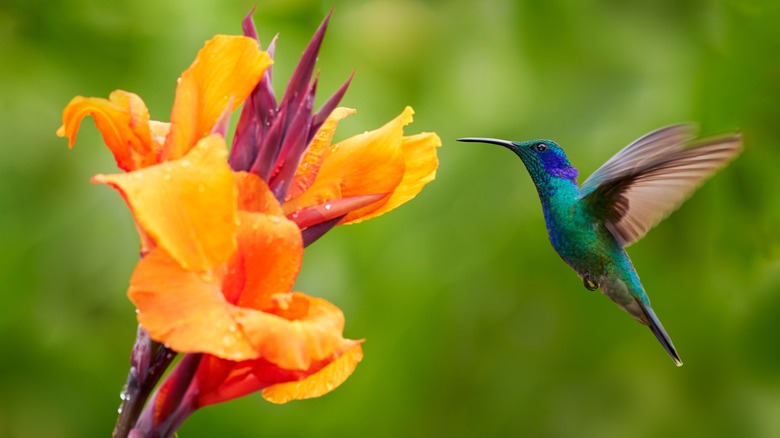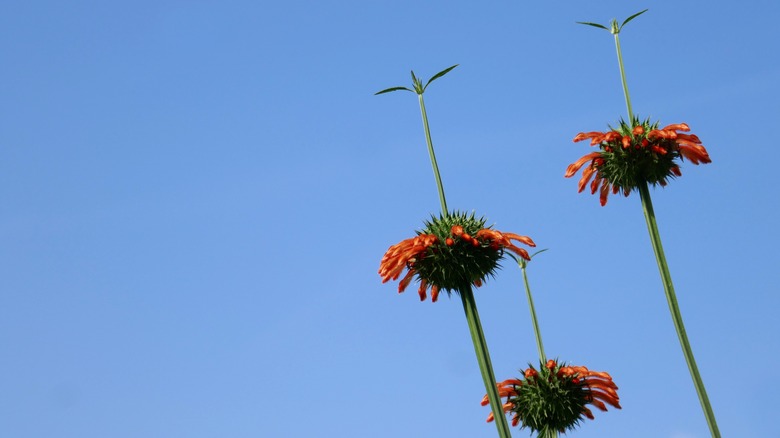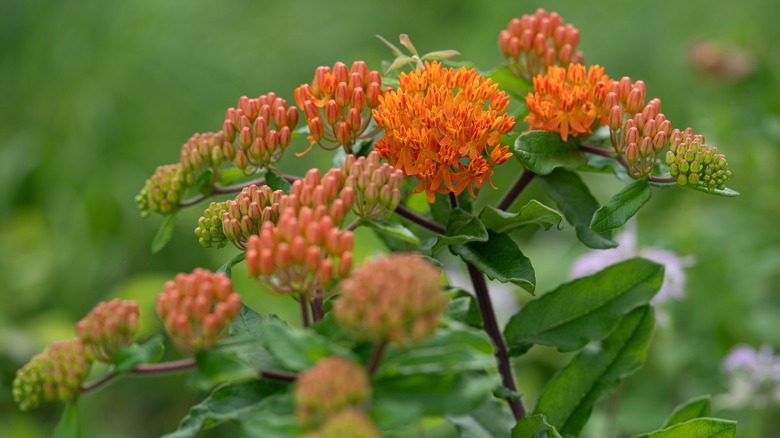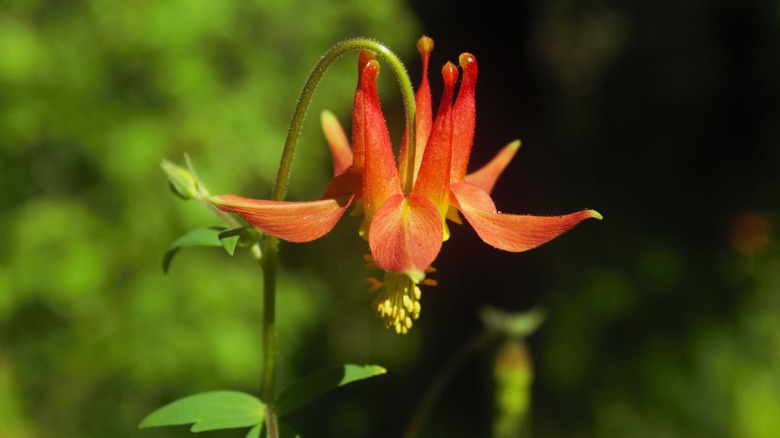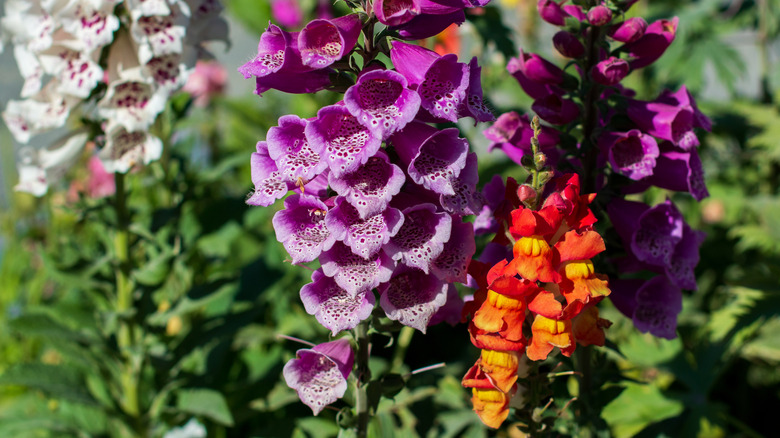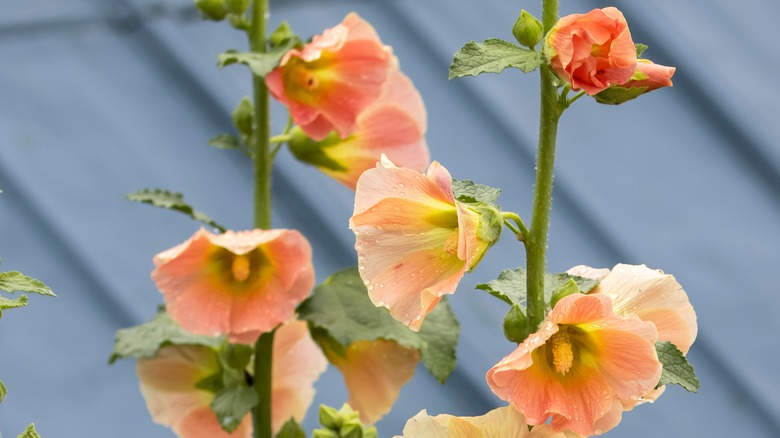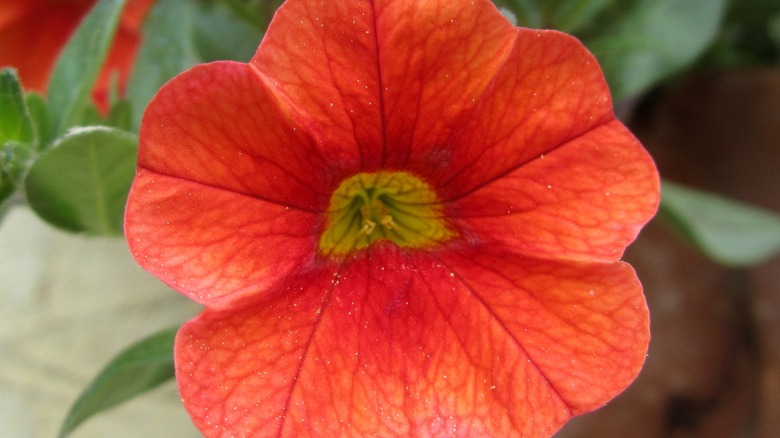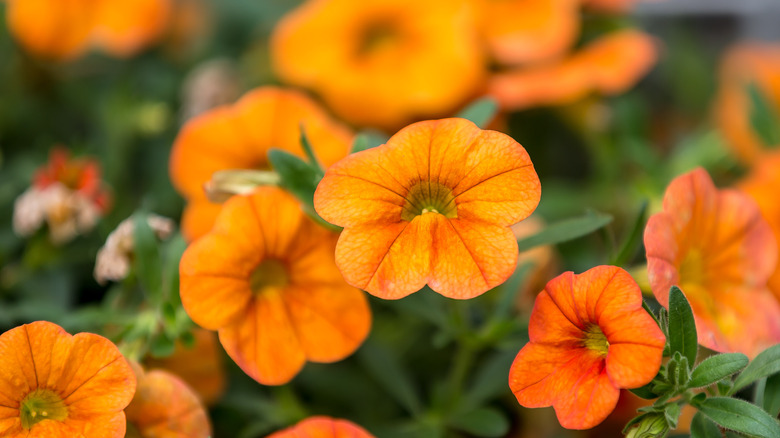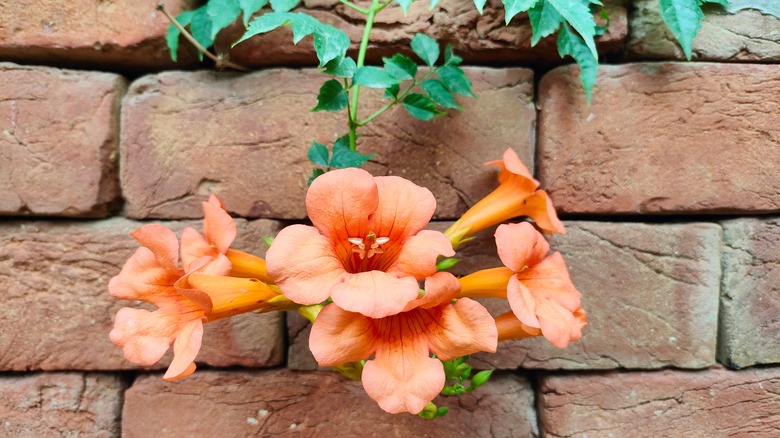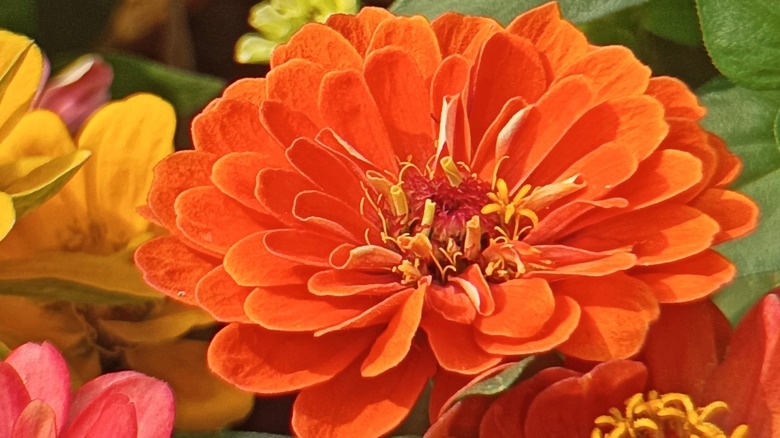Vibrant Orange Flowers That Hummingbirds Can't Resist
Hummingbirds are popular backyard and garden visitors, with many people wanting to offer them food in hopes that they will zip on by. While providing a hummingbird feeder (preferably with homemade nectar) is one such way you can attract hummingbirds to your garden, it's also worth considering nectar-producing flowers, too. In fact, hummingbirds eat from a variety of bright-colored flowers.
Red flowers tend to be the preference for these birds, which is why you might see mostly red hummingbird feeders available at bird supply stores. However, if you want to mix up the color scheme in your yard or garden, you can add other flowers with bright hues too. It's thought that these birds are primarily driven by color than they are the fragrance of a flower they want to scope out. There are in fact numerous flowers that hummingbirds absolutely love, and some even attract insects these birds eat as part of their diets. It turns out that hummingbirds are attracted to orange-colored flowers, and there are a variety of options you can plant to help feed these birds while also keeping your outdoor spaces looking beautiful.
Bee balm (Monarda) is an easy plant to grow to attract hummingbirds
One of the most widely available hummingbird-friendly flower is bee balm. Not only does it come in a variety of bright colors that attract hummingbirds, but the flower also blooms in tubular shapes that help these birds access them easily thanks to their long, slender beaks. Orange bee balm can be a gorgeous way to add color while also supporting hummingbirds and their ability to pollinate other plants, too.
Bee balm is relatively easy to grow, but there are a few key tips to help prevent these plants from disease. If you're looking to attract hummingbirds to your yard with this vibrant flower, you'll first need to know that it grows best in areas that have full sun to help prevent powdery mildew. At the same time, bee balm also tends to thrive in moist, but well-draining soil. You can also add mulch on top of the soil to help preserve water during drier months. When first planting bee balm, space each plant 2 feet apart from one another to help provide space for growth while also preventing possible transfer of powdery mildew.
Butterfly weed (Asclepias tuberosa) can provide nectar starting in late spring
As a member of the milkweed family, butterfly weed is considered a common perennial plant that is indigenous to most portions of North America. Due to its bright-orange color, this bushy plant is also known as orange milkweed. The tubular flowers are favored by hummingbirds as well as butterflies, and they tend to bloom starting in the late spring months as a food source for pollinating species.
While it's common to spot butterfly weed among large, open spaces, such as meadows or undisturbed roadsides, you can also help draw hummingbirds to your home by planting this perennial in your own yard. They also tend to do well with other perennial plants, such as goldenrods or coneflowers, if you'd like to add a pop of color with the natural orange blossoms. The key to successful planting and growing is to make sure your butterfly weed plants have full sun, light water, as well as well-draining soil. You can also grow them from seed, but be mindful that they can take up to three years to bloom. Also, while butterfly weed is notorious for aphid problems, these insects can be additional food sources for hummingbirds that stop by to feed from this plant.
Columbine (Aquilegia canadensis) is a native plant hummingbirds love
Columbine flowers are popular choices for attracting hummingbirds for several reasons. For one, these are native plants that support these birds without disrupting the natural ecosystem. The flower colors are vibrant, and they have unique dangling, upside-down appearing shapes that can add not just a pop of orange to your garden, but also a little bit of character as well. More importantly, the flowers offer a long tubular shape that makes it easy for hummingbirds to access their sweet nectar. The plant also attracts aphids, making it an indirect supporter of protein-rich food sources for hummingbirds, too.
When planting native columbine to attract hummingbirds, know that it can take two to three years for the plant to fully grow from seed. These are also perennial plants, though they are also self-seeding and can spread and continue to thrive in the right conditions. Furthermore, this native plant isn't too picky about sun, as it can grow well in both shady and sunny locations, as well as areas with part-shade.
Plant foxglove (Digitalis purpurea) for hummingbirds, but with caution
While perhaps best-known for their lavender and purple flowers, the common foxglove is also available in gorgeous orange varieties, too. These plants can grow tall, with the flowers the main focal point sticking out high above their leaves, which tend to bloom mostly in the early summer months. The picturesque flowers are native to Europe, and play host to several pollinating species every year, including hummingbirds, bees, and butterflies.
Foxglove plants are self-seeding like columbine plants, but they tend to need more sunlight and prefer either full sun or just partial shade. Like bee balm, foxglove can also develop powdery mildew problems. Take care to avoid touching foxglove without gardening gloves, as this plant may cause skin irritation. Furthermore, while hummingbirds will visit your yard for this tall and spikey flower, foxglove may not be the best choice if you have children or pets, as the plant can be toxic to humans as well as cats, dogs, and horses.
Hollyhock (Alcea rosea) attracts hummingbirds with tall flowers
Known for producing numerous flowers on each of their stems, hollyhocks, including hollyhocks in peachy-orange tones, are among one of the easiest ways to attract hummingbirds to your yard or garden. The birds can likely spot the plant's brightly-colored, numerous flowers with ease, and easily feast on the nectar due to the large blooms on sturdy stems.
When considering everything you should know before planting hollyhock, the best way is to start with plants from a garden center. Transplant them in a full-sun location in your garden, making sure you leave 12 to 18 inches of room in between each plant, as these can grow up to 8 feet tall. While the height can be beneficial for attracting hummingbirds, you might also consider planting these flowers towards the back part of your yard or garden, so they don't tower over any other plants.
Million bells (Calibrachoa) work well in hanging baskets
Due to million bells' bright colored flowers that also hold sweet nectar, you should consider planting this flower to lure hummingbirds to your garden. Aside from their bright orange flowers, million bells may also attract hummingbirds the most during early spring months when they begin blooming. These flowers also tend to best in warm southern regions, as they are indigenous to both Central and South America.
Since million bells are annuals in most areas, and can be killed frost, consider planting these flowers in planters that can easily be taken inside if the temperatures plummet. Better yet, consider placing them in hanging baskets that the hummingbirds can easily spot and feel comfortable flying to for a quick meal. While million bells plants don't require full sun compared to several other bright orange flowering plants on this list, fewer hours in the sun will ultimately mean fewer flowers, and possibly fewer hummingbirds as a result.
Petunias (Petunia spp.) can attract hummingbirds every spring
At the beginning of spring, consider planting petunias to attract hummingbirds while creating a vibrant display. Not only do petunias come in a variety of colors, but their brightest ones, such as orange blooms, can make a statement in your garden as hummingbirds zip through to quickly connect their nectar. Aside from hummingbirds, petunias will also attract butterflies that help pollinate their flowers.
While petunias are annual plants, they are easy to grow year after year. They grow well in both planters and directly in the ground as long as they have at least 6 hours of full sun. If you plant petunias in shady areas, they may still grow, but are less likely to produce flowers that both you and hummingbirds are looking for. To supplement their need for sun, you will also need to make sure the soil is kept moist to help petunias continue to thrive from spring to your region's first frost.
Hummingbirds feast on trumpet creeper (Campsis radicans) flowers from vines
If you're looking for a unique plant outside of traditional ones that grow in the ground or in planters, you may consider this musical-sounding flower to add color and attract hummingbirds to your yard. Unlike other flowers on this list, trumpet creeper flowers bloom in the spring. By having a variety of flowers in your garden such as these, you can help support hummingbirds throughout the year. Not only do hummingbirds appreciate the tall, bright orange flowers of this plant, but its trumpet-shaped blooms also make it easy for them to feed.
True to their name, trumpet creepers can also grow 30 feet or higher, depending on the height of its support system. Before planting, it's important to consider how much space you have in your yard or garden, as these can grow out of control quickly. One way to control this is to grow them in planters. You can also prune the plant often, especially during the winter months when its flowers are gone.
Zinnia (Zinnia L.) is a low-maintenance plant favored by hummingbirds
Zinnia is an annual plant that produces a variety of different colored flowers you can experiment with. Of course, when it comes to attracting hummingbirds, the brighter the color the better, and this includes orange zinnia flowers. Not only are these birds attracted to these flowers, but some gardeners also use these flowers as hummingbird bait on feeders as a way to encourage visits.
Like trumpet creepers, zinnias tend to thrive well in hot climates and bloom in the summer months. They're also considered easy to grow, with little maintenance needed. However, they need full sun, and you do need to make sure that they are watered frequently to prevent their soil from drying out. Also, the taller the zinnia plants, the easier hummingbirds and other pollinating species can access flower nectar. Zinnias are considered annuals that will need to be replaced every year.
